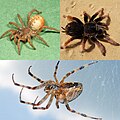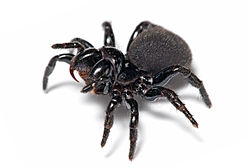araneoid spiders. Spider taxonomy Insect evolution Garwood, Russell J.; Dunlop, Jason (2014). "Three-dimensional reconstruction and the phylogeny of extinct...
14 KB (1,590 words) - 20:30, 24 May 2025
of the earliest forms, and spiders that produce tangled cobwebs are more abundant and diverse than orb-weaver spiders. Spider-like arachnids with silk-producing...
124 KB (13,698 words) - 17:30, 8 June 2025
architectures; other names for this spider family include tangle-web spiders and comb-footed spiders.[citation needed] When spiders moved from the water to the...
39 KB (4,609 words) - 22:50, 5 June 2025
scientific names of some 67 spiders species in his Svenska Spindlar ("Swedish Spiders"), one year before Linnaeus named over 30 spiders in his Systema Naturae...
34 KB (2,204 words) - 05:36, 25 May 2025
Orb-weaver spiders are members of the spider family Araneidae. They are the most common group of builders of spiral wheel-shaped webs often found in gardens...
43 KB (4,471 words) - 20:14, 23 May 2025
Sometimes one pair of eyes is better developed than the rest. Several families of hunting spiders, such as jumping spiders and wolf spiders, have fair to excellent...
12 KB (1,272 words) - 20:37, 26 May 2025
Arthropod (redirect from Evolution of arthropods)
(December 2007). "The Role of Behavior in the Evolution of Spiders, Silks, and Webs" (PDF). Annual Review of Ecology, Evolution, and Systematics. 38: 819–846...
142 KB (13,661 words) - 09:58, 20 June 2025
Arachnophobia (redirect from Fear of spiders)
is that the presence of venomous spiders led to the evolution of a fear of spiders, or made the acquisition of a fear of spiders especially easy. However...
18 KB (1,755 words) - 04:26, 27 May 2025
production of new spider webs. Some spiders, such as the dewdrop spiders (Argyrodes), even eat the silk of other spider species. Spiders typically have...
21 KB (2,561 words) - 06:29, 7 March 2025
Lampshade spiders, family Hypochilidae, are among the most primitive of araneomorph spiders. There are two genera and twelve species currently recognized...
7 KB (567 words) - 20:06, 26 October 2024
Chelicerata (redirect from Reproductive systems of chelicerates)
(kéras) 'horn') constitutes one of the major subdivisions of the phylum Arthropoda. Chelicerates include the sea spiders, horseshoe crabs, and arachnids...
84 KB (8,357 words) - 13:06, 20 June 2025
Mygalomorphae (section Evolution)
as trapdoor spiders due to their creation of trapdoors over their burrows. Other prominent groups include Australian funnel web spiders and tarantulas...
28 KB (1,845 words) - 15:09, 23 May 2025
and deep waters. Despite their name and brief resemblance, "sea spiders" are not spiders, nor even arachnids. While some literature around the 2000s suggests...
72 KB (7,142 words) - 18:53, 10 June 2025
Evolution is the change in the heritable characteristics of biological populations over successive generations. It occurs when evolutionary processes...
240 KB (25,077 words) - 21:13, 19 June 2025
diversification of molluscs through geologic time Evolution of spiders – Origin from a chelicerate ancestor and diversification of spiders through geologic...
26 KB (4,486 words) - 15:34, 30 January 2025
successful with time. Evolution of arthropods Evolution of butterflies Evolution of spiders "Landmark study on the evolution of insects". Sciencedaily...
99 KB (12,176 words) - 05:17, 21 June 2025
Deinopidae (redirect from Net-casting spider)
casting spiders, is a family of cribellate spiders first described by Carl Ludwig Koch in 1850. It consists of stick-like elongated spiders that catch...
4 KB (412 words) - 05:20, 25 May 2025
largest family of spiders – comprising 13% of spider species. Jumping spiders have some of the best vision among arthropods — being capable of stereoptic...
48 KB (5,063 words) - 14:46, 2 June 2025
A number of spiders can cause spider bites that are medically important. Almost all spiders produce venom but only a few are able to cause significant...
42 KB (4,908 words) - 04:54, 26 May 2025
passing prey in or near the mouth of a burrow. Wolf spiders resemble nursery web spiders (family Pisauridae), but wolf spiders carry their egg sacs by attaching...
26 KB (2,675 words) - 11:10, 22 June 2025
however, appear to be crucial for the evolution of sociality in spiders. Recent theory suggests that social spiders evolved along a restricted pathway through...
15 KB (1,742 words) - 17:11, 15 November 2024
Solifugae (redirect from Camel Spiders)
Solifugae is an order of arachnids known variously as solifuges, sun spiders, camel spiders, and wind scorpions. The order includes more than 1,000 described...
33 KB (3,438 words) - 04:41, 18 June 2025
endangered. Theories abound about the evolution of the atelines; one theory is they are most closely related to the woolly spider monkeys (Brachyteles), and most...
28 KB (3,005 words) - 07:35, 18 March 2025
(/əˈræknɪdə/) of the subphylum Chelicerata. Arachnida includes, among others, spiders, scorpions, ticks, mites, pseudoscorpions, harvestmen, camel spiders, whip...
55 KB (4,980 words) - 06:42, 2 June 2025
Chelicerae (redirect from Fang (spider))
(/kəˈlɪsəriː/) are the mouthparts of the subphylum Chelicerata, an arthropod group that includes arachnids, horseshoe crabs, and sea spiders. Commonly referred to...
9 KB (924 words) - 20:54, 24 May 2025
Opiliones (redirect from Harvest spider)
and often misidentified as spiders (order Araneae), the Opiliones are a distinct order that is not closely related to spiders. They can be easily distinguished...
65 KB (7,144 words) - 09:29, 22 June 2025
Parasteatoda tepidariorum (redirect from American house spider)
common house spider or American house spider, is a spider species of the genus Parasteatoda with a cosmopolitan distribution. Common house spiders are synanthropic...
9 KB (852 words) - 22:06, 25 May 2025
invertebrates caught mid-air is a spider. Out of 28,739 specimens, 1,401 turned out to be spiders. Ballooning is a behavior in which spiders and some other invertebrates...
16 KB (1,776 words) - 03:14, 29 March 2025
Mesothelae (redirect from Gigantic spider)
dividing spiders into two subgroups, Mesothelae for Liphistius, and Opisthothelae for all other spiders. The names refer to the position of the spinning...
16 KB (1,485 words) - 03:38, 8 May 2024
"Spider-Man™ Popsicle®". SPIDER-MAN ANIMATED SERIES RANKED WORST TO BEST, on The Nerdist. The Evolution of Spider-Man: A Comparative Analysis of Different...
40 KB (3,378 words) - 07:56, 25 May 2025



























